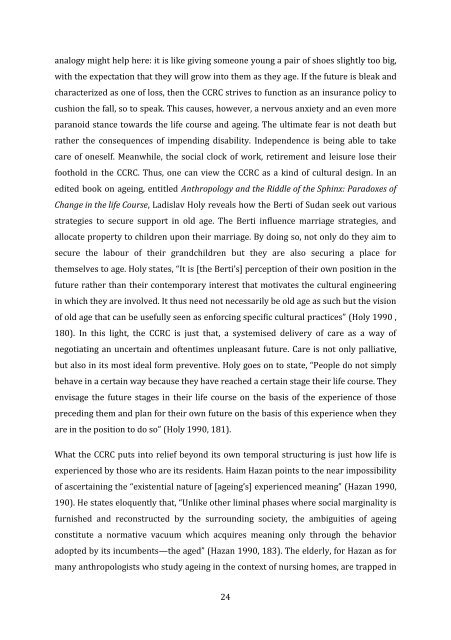Philip Y. Kao PhD thesis - Research@StAndrews:FullText
Philip Y. Kao PhD thesis - Research@StAndrews:FullText
Philip Y. Kao PhD thesis - Research@StAndrews:FullText
Create successful ePaper yourself
Turn your PDF publications into a flip-book with our unique Google optimized e-Paper software.
analogy might help here: it is like giving someone young a pair of shoes slightly too big,<br />
with the expectation that they will grow into them as they age. If the future is bleak and<br />
characterized as one of loss, then the CCRC strives to function as an insurance policy to<br />
cushion the fall, so to speak. This causes, however, a nervous anxiety and an even more<br />
paranoid stance towards the life course and ageing. The ultimate fear is not death but<br />
rather the consequences of impending disability. Independence is being able to take<br />
care of oneself. Meanwhile, the social clock of work, retirement and leisure lose their<br />
foothold in the CCRC. Thus, one can view the CCRC as a kind of cultural design. In an<br />
edited book on ageing, entitled Anthropology and the Riddle of the Sphinx: Paradoxes of<br />
Change in the life Course, Ladislav Holy reveals how the Berti of Sudan seek out various<br />
strategies to secure support in old age. The Berti influence marriage strategies, and<br />
allocate property to children upon their marriage. By doing so, not only do they aim to<br />
secure the labour of their grandchildren but they are also securing a place for<br />
themselves to age. Holy states, “It is [the Berti’s] perception of their own position in the<br />
future rather than their contemporary interest that motivates the cultural engineering<br />
in which they are involved. It thus need not necessarily be old age as such but the vision<br />
of old age that can be usefully seen as enforcing specific cultural practices” (Holy 1990 ,<br />
180). In this light, the CCRC is just that, a systemised delivery of care as a way of<br />
negotiating an uncertain and oftentimes unpleasant future. Care is not only palliative,<br />
but also in its most ideal form preventive. Holy goes on to state, “People do not simply<br />
behave in a certain way because they have reached a certain stage their life course. They<br />
envisage the future stages in their life course on the basis of the experience of those<br />
preceding them and plan for their own future on the basis of this experience when they<br />
are in the position to do so” (Holy 1990, 181).<br />
What the CCRC puts into relief beyond its own temporal structuring is just how life is<br />
experienced by those who are its residents. Haim Hazan points to the near impossibility<br />
of ascertaining the “existential nature of [ageing’s] experienced meaning” (Hazan 1990,<br />
190). He states eloquently that, “Unlike other liminal phases where social marginality is<br />
furnished and reconstructed by the surrounding society, the ambiguities of ageing<br />
constitute a normative vacuum which acquires meaning only through the behavior<br />
adopted by its incumbents—the aged” (Hazan 1990, 183). The elderly, for Hazan as for<br />
many anthropologists who study ageing in the context of nursing homes, are trapped in<br />
24
















